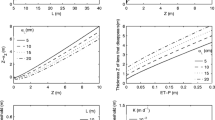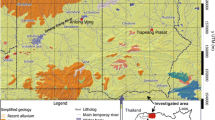Abstract
To survive on this planet, to thrive, and to lead a healthy life, water is a basic and essential need. Now, with the growing population, booming industrialization, enhancement of living standards, and changing climate, water has become an asset that we must preserve carefully. Water is presently a major topic of discussion and debate and a matter of possible conflict in the coming years among different provinces, states, countries, and even continents. With the rapidly declining reserves of this asset, the world is looking for solutions for its better management and conservation. This article emphasizes the storage and conservation of underground water in the subsurface porous media. But how does it work in reality? Let us discuss this in detail.
Similar content being viewed by others
Suggested Reading
The Water in You: Water and the Human Body, United States Geological Survey (USGS), https://www.usgs.gov/special-topics/water-science-school/science/water-you-water-and-human-body.
V T Chow, D R Maidment and L W Mays, Applied Hydrology, McGraw Hill (Education), 2010.
E Hameeteman, Future Water (In)security: Facts, Figures, and Predictions, Global Water Institute, 2013.
World Health Organization (WHO) Website, https://www.who.int/.
Saline Water and Salinity, United States Geological Survey (USGS), https://www.usgs.gov/special-topics/water-science-school/science/saline-water-and-salinity.
SDG 6: Synthesis Report on Water and Sanitation: UN-Water, United Nations. 2018
H Fahlbusch and Early dams, Proceedings of the Institution of Civil Engineers—Engineering History and Heritage, Vol.162, No.1, pp.13–18, 2009.
Aquifer Recharge and Aquifer Storage and Recovery, United States Environmental Protection Agency.
M Rodell, I Velicogna, J S Famiglietti, Satellite-based estimates of groundwater depletion in India, Nature, Vol.460, pp.999–1002, 2009.
F Rambags et al., Aquifer storage and recovery (ASR): Design and operational experiences for water storage through wells, Report number: Prepared 2012.016.2013.
Manual on Artificial Recharge of Groundwater, Central Ground Water Board, Ministry of Water Resources, Government of India 2007.
P Dillon et al., A Water Quality Guide to Managed Aquifer Recharge in India, CSIRO Land and Water Flagship and UNESCO, 2014.
National Water Policy, Ministry of Water Resources, Govt. of India, 2002.
National Water Policy, Ministry of Water Resources, Govt. of India, 2012.
Acknowledgements
The author gratefully acknowledges the financial help received from Science and Engineering Research Board (SERB), Department of Science and Technology, Govt. of India, for the project titled ‘A feasibility study on aquifer storage of water by artificial recharge in and around Punjab region, India’ (Grant no.: SRG/2019/000738). The author also acknowledges the valuable comments and suggestions made by the Editor and the anonymous reviewers, which helped to improve the overall quality of the manuscript.
Author information
Authors and Affiliations
Corresponding author
Additional information
Sayantan Ganguly is an Assistant Professor in the Department of Civil Engineering, Indian Institute of Technology Ropar. His research interests and expertise include hydrogeology, groundwater, water resources and water conservation.
Rights and permissions
About this article
Cite this article
Ganguly, S. Subsurface Storage of Water. Reson 27, 561–578 (2022). https://doi.org/10.1007/s12045-022-1349-7
Published:
Issue Date:
DOI: https://doi.org/10.1007/s12045-022-1349-7




